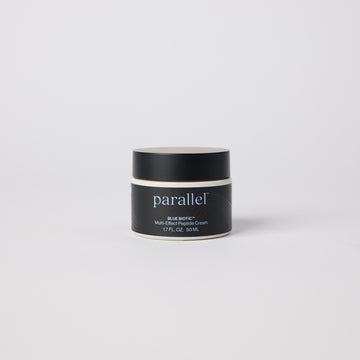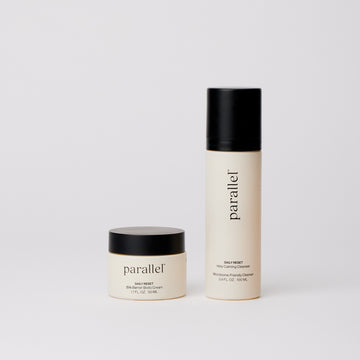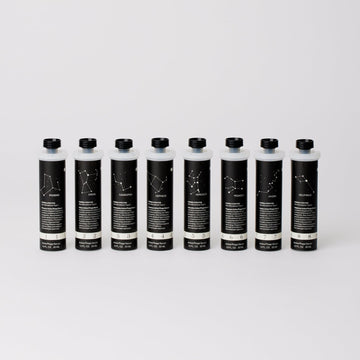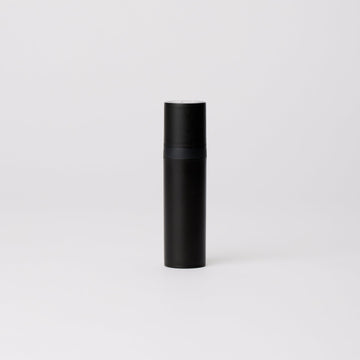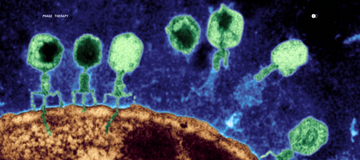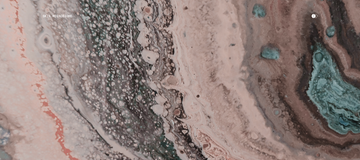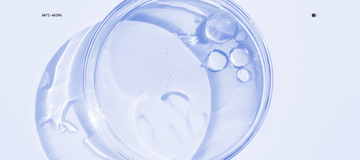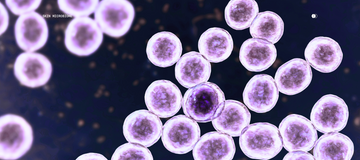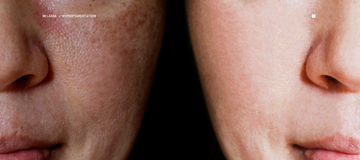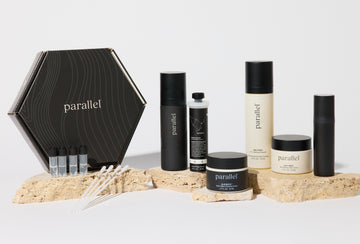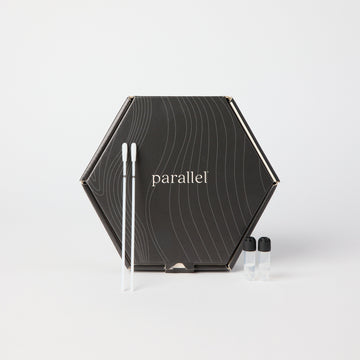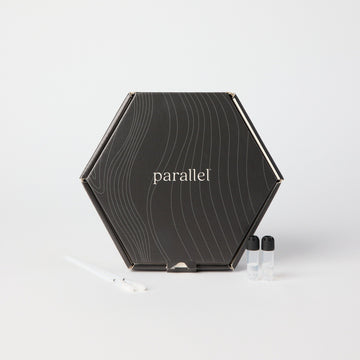Imagine a microscopic battlefield spanning every square inch of your skin. Right now, as you read this, trillions of invisible warriors are locked in an ancient struggle for territory across your face, hands, and body. Some are allies—protective guardians that have co-evolved with humans for millennia, manufacturing antimicrobial compounds and maintaining your skin's delicate pH balance. Others are opportunistic invaders, forming biofilms, triggering inflammation, and accelerating the aging process with every passing day.
This is your skin microbiome—a complex ecosystem more biodiverse than a rainforest canopy and crucial to your skin health and appearance. For decades, the beauty industry has waged war on aging by targeting wrinkles, dark spots, and dryness. But what if we've been fighting the wrong battle entirely?
Scientists are now discovering that skin aging begins not in your dermis or epidermis, but in the microscopic realm of bacteria, viruses, and fungi that call your skin home. As we age, this delicate ecosystem falls out of balance. Harmful bacteria multiply while beneficial species retreat. The result? Chronic inflammation, compromised barrier function, and the visible signs of aging we desperately try to reverse.
Enter Microbiome Dermatology™—Parallel Health's revolutionary approach that treats your skin's bacterial ecosystem as the foundation of healthy aging. We're pioneering a sophisticated dual-therapy system that combines precision topical phage therapy with targeted topical biotics (pre, pro, and post-biotics). This isn't cosmetic chemistry—it's biological engineering at the microscopic scale.
Understanding Your Skin's Hidden Ecosystem
Your skin hosts trillions of microorganisms in a complex ecosystem called the skin microbiome. When balanced, this microscopic community acts as your first line of defense, producing antimicrobial compounds, maintaining pH balance, and supporting barrier function. However, aging, environmental stressors, and modern lifestyles disrupt this delicate balance.
Research shows that skin aging accelerates when harmful bacteria proliferate while beneficial species decline. This microbial imbalance triggers chronic low-grade inflammation—the primary driver of premature aging, barrier dysfunction, and skin sensitivity.
Precision Phage Therapy: Nature's Surgical Strike
Bacteriophages are nano-microbes that have evolved over billions of years to target and eliminate specific bacterial strains with remarkable precision. Unlike broad-spectrum antimicrobials that destroy both good and bad bacteria, phages act like guided missiles—seeking out and neutralizing only their target pathogens.
In topical phage therapy, natural, laboratory-selected bacteriophages are applied directly to the skin to eliminate specific harmful bacterial strains identified through microbiome testing. This precision approach clears pathogenic bacteria while preserving the beneficial microbes essential for healthy skin function.
The beauty of phage therapy lies in its specificity. Each phage strain targets a particular bacterial species, allowing dermatologists to craft personalized treatment protocols based on individual microbiome analysis. This level of precision was impossible until recent advances in microbiome sequencing and phage cultivation technologies.
Strategic Microbiome Repopulation: The Complete Prebiotic-Probiotic-Postbiotic System
While phages clear unwanted bacteria, strategic repopulation requires a sophisticated three-pronged approach: prebiotics, probiotics, and postbiotics working in concert to rebuild and maintain optimal skin ecology.
Topical Probiotics introduce beneficial microorganisms directly to the skin surface. These carefully selected bacterial strains—including Lactobacillus plantarum, Bifidobacterium longum, and proprietary Staphylococcus variants—actively colonize cleared skin terrain. Unlike dietary probiotics that must survive digestive processes, topical application delivers cultures directly where they're needed most.
Topical Prebiotics provide targeted nutrition for beneficial bacteria, ensuring their successful establishment and proliferation. These specialized compounds—such as oligosaccharides, inulin derivatives, and specific amino acid complexes—selectively feed protective microbes while starving pathogenic species. Prebiotics essentially create a nutritional advantage that tips the microbial balance toward skin health.
Topical Postbiotics deliver the beneficial metabolites and cellular components produced by probiotic bacteria without requiring live cultures. These bioactive compounds—including bacterial lysates, peptides, enzymes like sphingomyelinase, and short-chain fatty acids—provide immediate therapeutic benefits. Postbiotics offer the advantage of stability and can work synergistically with probiotics to enhance barrier function and reduce inflammation.
This integrated system works through multiple mechanisms: producing natural antimicrobial peptides, synthesizing hyaluronic acid and ceramides, modulating local immune responses, and creating an acidic environment that prevents pathogen recolonization. The combination ensures both immediate benefits and long-term microbial stability.
The Synergistic Power of Dual Therapy
The combination of precision phage therapy and topical biotics creates a sophisticated microbiome engineering system. Phages perform the "demolition" phase—eliminating specific pathogenic strains that contribute to inflammation and aging. Biotics handle the "construction" phase—populating the cleared microbial real estate with beneficial bacteria optimized for skin longevity.
This sequential approach maximizes therapeutic efficacy. Without prior pathogen elimination, probiotics must compete with established harmful bacteria for resources and binding sites. Conversely, phage therapy alone leaves cleared terrain vulnerable to recolonization by opportunistic pathogens. Together, this system creates a comprehensive microbiome reset.
Clinical studies demonstrate that dual phage-biotic therapy significantly outperforms either treatment alone, showing superior improvements in barrier function, hydration retention, and inflammatory markers associated with skin aging.
Personalized Microbiome Engineering for Optimal Results
Effective microbiome engineering requires precision diagnostics. Through advanced microbiome sequencing, Parallel Health identifies each patient's unique bacterial profile, pathogenic imbalances, and probiotic deficiencies. This data drives personalized phage selection and biotic strain matching.
The result is a customized dual-therapy protocol that addresses your specific microbiome dysfunction patterns. Rather than generic skincare formulations, you receive targeted bacterial interventions designed for your skin's unique ecosystem.
The Future of Skin Longevity
Microbiome Dermatology™ represents a fundamental shift from reactive skincare to proactive microbiome optimization. By engineering the bacterial foundation of skin health, we can address aging at its microbial roots rather than treating surface-level symptoms.
As our understanding of the skin microbiome deepens, precision phage therapy and topical probiotics will become cornerstones of evidence-based skincare. The future belongs to those who engineer their skin's ecosystem with scientific precision—because healthy skin starts with healthy bacteria.
Discover how Parallel Health's Microbiome Dermatology™ approach can optimize your unique bacterial landscape for lasting skin longevity.
Scientific References
-
Parlet, C. P., et al. (2023). Bacteriophages and the Microbiome in Dermatology: The Role of the Phageome and a Potential Therapeutic Strategy. International Journal of Molecular Sciences, 24(3), 2695.
-
Ott, S. J., et al. (2021). Assessment of the microbiome during bacteriophage therapy in combination with systemic antibiotics to treat a case of staphylococcal device infection. Microbiome, 9, 92.
-
Federici, S., et al. (2023). The phageome in normal and inflamed human skin. Science Advances, 9(31), eadg4015.
-
Wang, Y., et al. (2019). Bacteriophage of the Skin Microbiome in Patients with Psoriasis and Healthy Family Controls. Journal of Investigative Dermatology, 139(9), 2058-2061.
-
De Pessemier, B., et al. (2021). Gut–Skin Axis: Current Knowledge of the Interrelationship between Microbial Dysbiosis and Skin Conditions. Microorganisms, 9(2), 353.
-
Woo, Y. R., & Kim, H. S. (2024). Interaction between the microbiota and the skin barrier in aging skin: a comprehensive review. Frontiers in Physiology, 15, 1322205.
-
Sharma, D., et al. (2016). Anti-Aging Effects of Probiotics. Journal of Drugs in Dermatology, 15(1), 9-12.
-
Habeebuddin, M., et al. (2022). Topical Probiotics: More Than a Skin Deep. Pharmaceutics, 14(3), 557.
-
Di Marzio, L., et al. (2008). Increase of skin-ceramide levels in aged subjects following a short-term topical application of bacterial sphingomyelinase from Streptococcus thermophilus. International Journal of Immunopathology and Pharmacology, 21(1), 137-143.
-
Howard, B., et al. (2013). Aging-Associated Changes in the Adult Human Skin Microbiome and the Host Factors that Affect Skin Microbiome Composition. Journal of Investigative Dermatology, 133(10), 2463-2470.
-
Zheng, Y., et al. (2022). Commensal Staphylococcus epidermidis contributes to skin barrier homeostasis by generating protective ceramides. Cell Host & Microbe, 30(3), 301-313.


